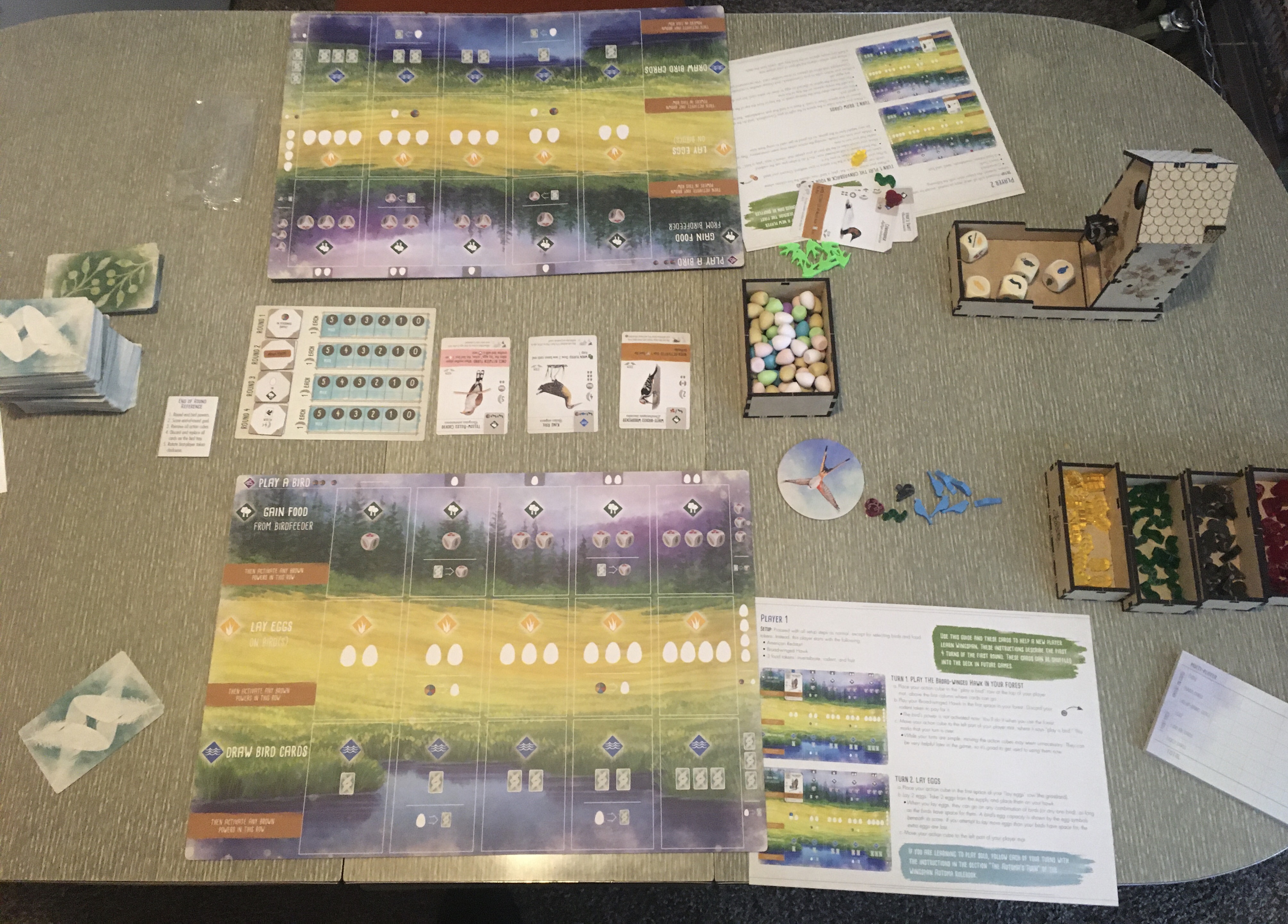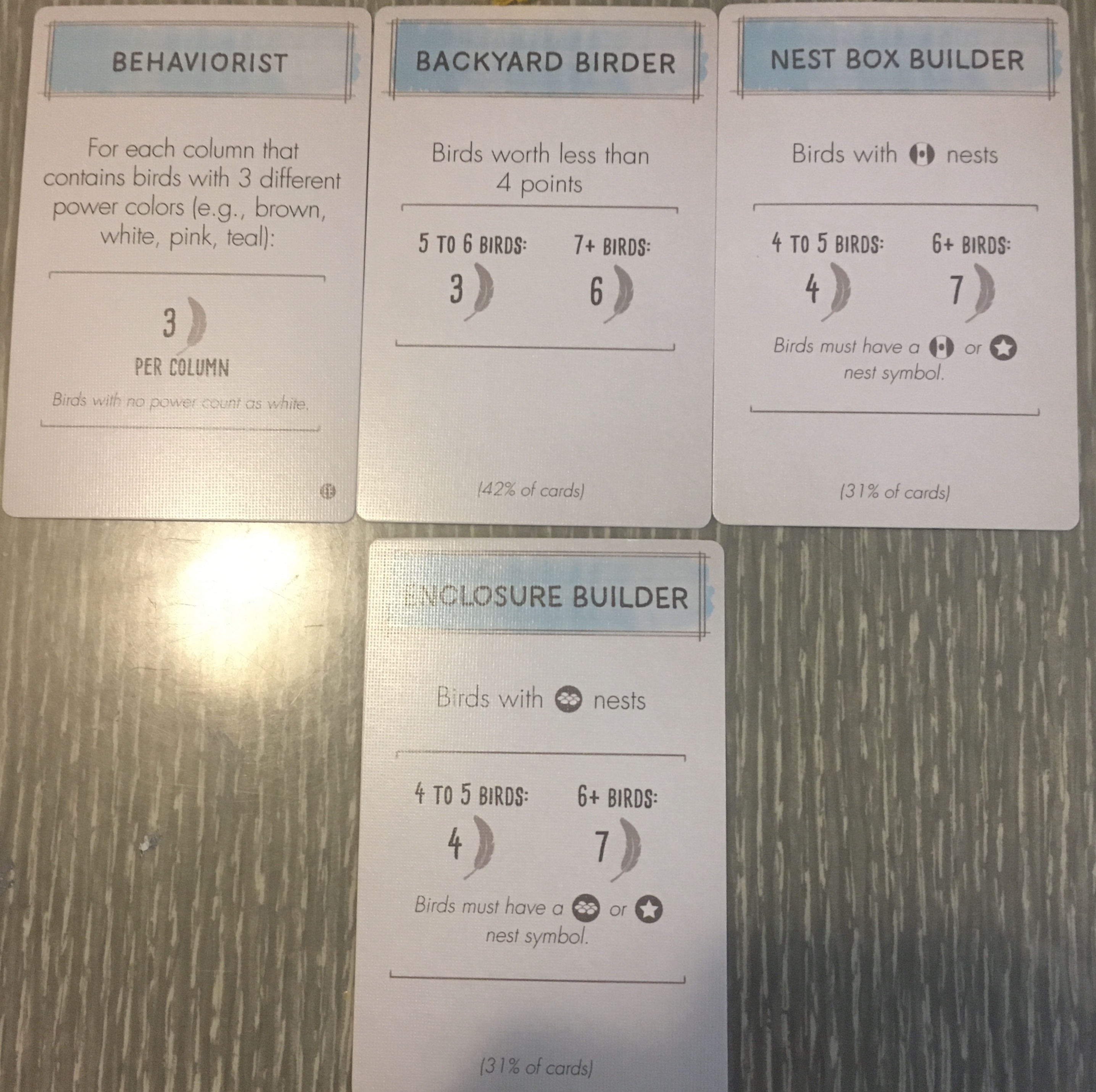





Date played: November 28, 2020
Basic details: 1-5 players; 40-70 minutes; competitive; solo mode available
Gist of the game: You are a bird enthusiast trying to attract and entice birds into your nature preserve. Birds create and extend chains of combinations within their habitat, and each habitat focuses on one aspect of the growth of your nature preserve. The player with the most points at the end of the game wins.
To start the game, each player receives a player mat, 8 action cubes in their chosen color, 2 random bonus cards, of which they choose one, and 1 of each type of food token. The remaining goal cards are shuffled and placed face-down in a draw deck. 3 birds are placed face up in the display and the draw deck set aside within reach. The goal board is laid out. The green side of the board involves more direct competition, providing more points to the player with the most of that thing. The blue side involves less direct competition, and all players can earn a maximum of 5 points for each goal. The goal tiles are shuffled and 1 goal tile is placed random side up on each blank space on the goal board. The 5 food dice are rolled. Next, players keep up to 5 of their cards and discard the others, discarding a food token for each bird they keep.
The game is played over 4 rounds with each successive round containing 1 fewer turn than the round before it, so that in the first round players take 8 turns, while in the 4th round each player takes 5 turns.
On each turn, players take 1 of 4 possible actions: a) play a bird from their hand; b) gain food and activate forest bird powers; c) lay eggs and activate grassland bird powers; or d) draw bird cards and activate wetland bird powers.
When playing a bird, players choose a bird form their hand and place an action cube at the top of the column in which they will play the bird. The player pays any corresponding egg and food costs. The bird is placed on the leftmost available spot in the appropriate habitat and the action cube is moved to the left side of the “play a bird” row. If the bird has any “when played” powers, they are activated and the player may use that power if they wish.
When gaining food and activating forest bird powers, the player places an action cube in the leftmost open spot in the “gain food” row of the player mat and gains the amount of food shown on the spot from the birdfeeder dice tray. At the start of the game, the food dice are rolled. That stock of food is depleted until no food remains or all remaining dice show the same food, at which point the food dice can be rerolled. When choosing food dice, the player removes the dice from the birdfeeder and gains the matching food token. Players always gain 1 token per die. If the spot where the action cube is placed shows a card-to-food bonus, the player may discard a bird card from their hand to gain an additional food (taking another die from the birdfeeder). Then, any brown powers on birds in the forest habitat are activated from right to left. The player does not have to activate all powers, choosing to use some but not others.
When laying eggs and activating grassland birds, players must place an action cube in the leftmost open spot in the “lay eggs” row of the player mat and lay that number of eggs. To lay an egg, the player takes an egg token (all egg colors are perfectly interchangeable) and places it on a bird card that has space for it. The number of eggs a bird can hold is indicated on the bird’s card. Eggs can be placed on any combination of birds so long as the birds’ egg limits have not been reached. Any eggs beyond all birds’ ability to hold them are simply lost. If the spot where the action cube was placed shows a food-to-egg bonus conversion, players can pay 1 food token from their supply to lay an additional egg. Brown powers on grassland birds are then activated from right to left.
To draw bird cards and activate wetland birds, players place an action cube on the leftmost open spot in the “draw cards” role on the player mat, and draw the number of cards indicated from either the face-up bird cards or the bird deck. There is no hand limit. If the spot with the action cube shows an egg-to-card bonus conversion, players may discard an egg from a bird to draw an additional card. Brown powers on wetland birds are activated from right to left. If a bird is chosen from the face-up display, it is not replaced until the end of the turn.
When all players have played all their action cubes, the round ends. All action cubes are removed from the player mat. The end-of-round goal for that round is scored, using one of each player’s action cubes as a score marker, thus leaving them with 1 fewer cube for the next round. All face-up birds in the bird display are discarded and replaced. The first player token shifts to the next player.
At the end of the 4th round, birds on the player mat and bonus cards are scored. Players also receive 1 point for each: egg cached on a bird, food token cached on a bird, and card tucked under a bird. The player with the most points ends.
The European expansion adds more birds and end-of-round actions for birds (we played with this expansion). The Oceania expansion adds more birds and also nectar as a new type of food, along with end-of-game actions for birds (we did not play with this expansion, but will next time!).
Color commentary: This is a really interesting game that forces you to think very carefully about short-term vs. long-term gains and which to maximize at any particular point. Being able to think out the next several turns at any given time is helpful. You can get points from each end-of-round bonus, but each round offers points for different things than you get points for at the end of the game, and the 2 sets of goals may not overlap much. Additionally, being able to cache eggs is especially valuable at the end of the game, but also makes playing new, possibly valuable, birds easier as well. Not all the personal bonus cards were helpful in a practical sense, because of needing several birds to qualify for a small number of points. I definitely consistently earned more points from the end-of-round bonuses than the end-of-game bonuses.
The artwork is beautiful and there’s an opportunity for at least some education, as each bird card presents some information about the bird, even if in stylized fashion.
I’m really glad the game was good, thus retroactively justifying the expansion and upgrade purchases I made before playing the game. There is a downside to the expansions, though. There are so many bird cards (hundreds), and you don’t see that many during a game, so it would take several dozen plays to play with all the cards at least once. The variety is nice, and increases variety and replayability, but there’s so much variety that I think a lot of it will go unappreciated over time.
Thoughts from M: The food dice are super nifty and aesthetically pleasing. I wish I could think of other uses for them. And the birdfeeder dice tower was also a nice touch. The game is complicated, though, and there’s no single clear strategy that would work every time. The game is dozens of optimization problems to be solved at any given moment. Also, I like realistic games, that reflect the real world. That’s why I enjoy Camping with Sasquatch, or playing our Godzilla-themed games, or games where apes have to keep down humans hell-bent on war. But birds? BIRDS?! Everyone knows that birds aren’t real, and this game is just a step too far into the fantastic. If they could use the same mechanics with a more believable subject, I do believe I would rate this game higher.
Petra’s rating: 10/10
M’s rating: 7/10